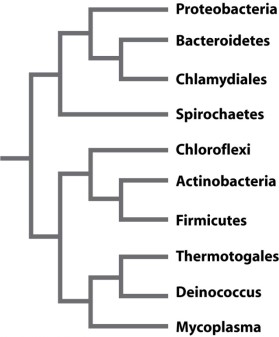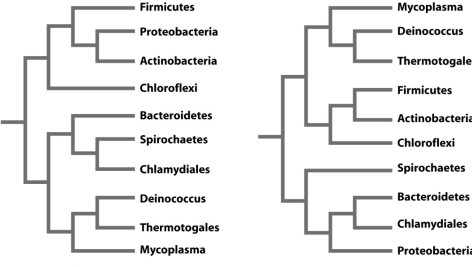Scientists generate phylogenetic trees for a group of organisms using molecular data such as gene sequences. The 16S rRNA gene is used for this type of analysis because the gene phylogeny accurately reproduces the evolutionary history of the organisms from which the sequences were derived. Assume that the phylogeny below, which was produced based on analysis of the 16S rRNA gene, represents the evolutionary history of bacteria.  You are interested in determining other genes that may be used to recover the same phylogeny. For each microbe in the tree, you sequence two other genes. The first is rpoB, which encodes one of the subunits in RNA polymerase holoenzyme and is located on the bacterial chromosome. The second is cat, a gene that confers resistance to the antibiotic chloramphenicol (a drug that targets the ribosome) and is located on a plasmid. Examine the two trees below. On the left is the phylogeny recovered using cat sequences and on the right is the phylogeny recovered using rpoB sequences.
You are interested in determining other genes that may be used to recover the same phylogeny. For each microbe in the tree, you sequence two other genes. The first is rpoB, which encodes one of the subunits in RNA polymerase holoenzyme and is located on the bacterial chromosome. The second is cat, a gene that confers resistance to the antibiotic chloramphenicol (a drug that targets the ribosome) and is located on a plasmid. Examine the two trees below. On the left is the phylogeny recovered using cat sequences and on the right is the phylogeny recovered using rpoB sequences.  One of the two trees supports the hypothesis presented in the 16S rRNA gene phylogeny for this group of bacteria. Which of the following helps to explain why only one of the two trees matches the 16S rRNA gene phylogeny?
One of the two trees supports the hypothesis presented in the 16S rRNA gene phylogeny for this group of bacteria. Which of the following helps to explain why only one of the two trees matches the 16S rRNA gene phylogeny?
A) One of the genes was transferred horizontally between groups of bacteria.
B) Both genes encode proteins responsible for essential functions in all cells.
C) One of the genes is inherited from a common ancestor, passed from parent to offspring.
D) One of the genes gives this group of bacteria a beneficial growth advantage when grown in the presence of antibiotics.
E) One of the genes produces a phylogeny that is the same as the phylogeny produced using the 16S RNA gene.
Correct Answer:
Verified
Q82: Which of the following organisms can DIRECTLY
Q83: A veterinarian wants to determine what types
Q84: Photosynthetic bacteria are all found on one
Q85: Like carbon, copious amounts of nitrogen are
Q86: _ is an element that is abundant
Q88: Nitrogen gas (N2) in the atmosphere can
Q89: Why are scientists unable to grow the
Q90: Two graduate students are trying to identify
Q91: Cyanobacteria are the most diverse group of
Q92: There are bacteria that live on single-celled
Unlock this Answer For Free Now!
View this answer and more for free by performing one of the following actions

Scan the QR code to install the App and get 2 free unlocks

Unlock quizzes for free by uploading documents